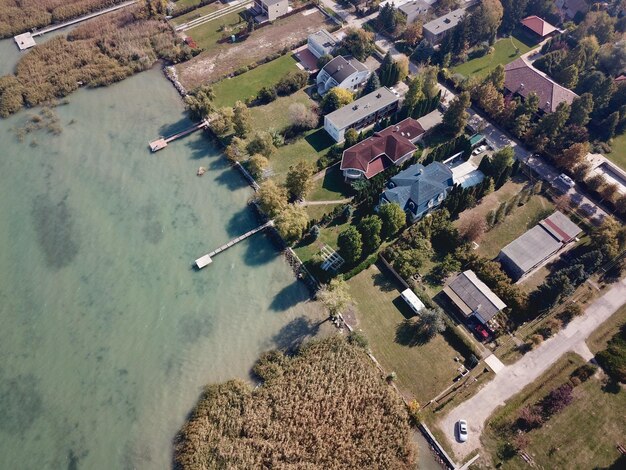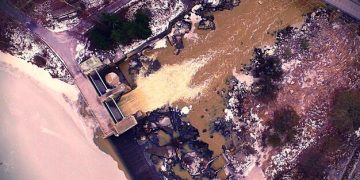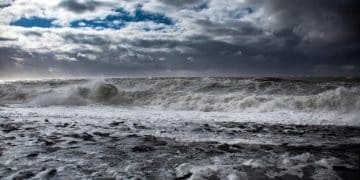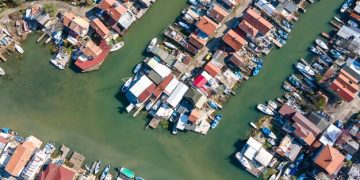US Coastal Communities: Projected Economic Losses from Sea Level Rise in 5 Years

The projected economic losses in US coastal communities due to rising sea levels over the next five years are anticipated to be substantial, encompassing billions of dollars in infrastructure damage, property devaluation, disrupted economic activities, and increased adaptation costs, posing a significant challenge to local and national economies.
The relentless march of climate change continues to reshapes our world, and few phenomena illustrate this impact more starkly than rising sea levels. For the United States, a nation boasting thousands of miles of coastline, this is not a distant threat but a palpable, escalating reality. The pressing question for many, particularly those living and working in these vulnerable areas, is: What are the Projected Economic Losses in US Coastal Communities Due to Rising Sea Levels in the Next 5 Years? This query delves into the tangible, fiscal consequences that short-term climate shifts are poised to impose, offering a critical lens through which to view the urgency of adaptation and mitigation strategies.
Understanding the Mechanics of Sea Level Rise and Its Direct Economic Impacts
Sea level rise is a multifaceted phenomenon driven primarily by two factors: thermal expansion of ocean water as it warms and the melting of glaciers and ice sheets. While the global average rise may seem incremental year to year, its localized effects, exacerbated by tidal cycles, storm surges, and land subsidence, can be dramatically higher in specific coastal regions of the US. This accelerated rise translates directly into significant economic liabilities.
The immediate consequence is often manifest in infrastructure damage. Roads, bridges, wastewater treatment plants, and energy facilities located in low-lying coastal areas are increasingly vulnerable to inundation and saltwater intrusion. Repairing and elevating these critical systems requires immense capital investment. Beyond direct structural harm, rising waters undermine foundations, corrode materials, and compromise the operational integrity of essential services, leading to ongoing maintenance burdens and potential service disruptions.
Impact on Property Value and Insurance Markets
One of the most direct and tangible economic impacts of rising sea levels is the deprecation of coastal property values. As flood risks increase, the desirability and insurability of homes and businesses in affected zones diminish. This trend can create a cascading effect throughout local economies.
- Devaluation of Real Estate: Homes and commercial properties in vulnerable areas may lose significant market value, impacting homeowners’ equity and municipal tax bases.
- Increased Insurance Premiums: Flood insurance rates, particularly through the National Flood Insurance Program (NFIP), are projected to rise significantly to reflect the escalating risk, making coastal living less affordable.
- “Uninsurable” Properties: Some properties may eventually become uninsurable, leading to financial ruin for owners and potentially stranding assets.
This market shift isn’t just a concern for property owners; it affects lenders, real estate agents, and municipal planners, creating a ripple effect across financial sectors dependent on property stability.
Disruption to Coastal Industries and Livelihoods
Coastal communities often rely heavily on marine and tourism industries. Rising sea levels directly threaten these economic pillars. Fisheries, for example, can be affected by changes in ocean chemistry and habitats, while port operations face disruptions due to altered navigability and damaged infrastructure. The tourism sector, reliant on pristine beaches and accessible waterfronts, sees direct impacts from erosion and inundation.
Consider the myriad businesses nestled along coastal stretches – restaurants, hotels, retail shops – all of which depend on a vibrant, accessible shoreline. Inundation can lead to temporary or permanent closures, loss of revenue, and job displacement. This economic downturn extends beyond the immediate coastal zone, affecting supply chains and related services further inland. The cumulative effect can lead to significant regional economic contractions, with job losses and reduced local tax revenues.
The economic burden extends beyond direct damage. It encompasses the costs of protecting vulnerable assets, relocating communities, and adapting to a new normal. These proactive measures, while essential, represent substantial expenditures that divert resources from other vital public services and private investments. The challenge lies in balancing immediate costs with the far greater long-term expenses of inaction. The next five years will be crucial in observing how these pressures manifest and compel adaptation.
Quantifying the Near-Term Economic Projections: Methods and Challenges
Projecting economic losses from rising sea levels over a relatively short, five-year timeframe is a complex undertaking, relying on sophisticated modeling and a deep understanding of localized vulnerabilities. Researchers and economists use various methodologies to forecast these impacts, focusing on both direct and indirect costs while acknowledging inherent uncertainties.
One primary method involves analyzing flood exposure data combined with property values and projected sea level rise scenarios. This allows for estimates of potential damages to residential and commercial real estate. Actuarial science plays a crucial role in assessing future insurance liabilities and the solvency of programs like the NFIP. Furthermore, economic input-output models are employed to understand the broader ripple effects of direct losses across different sectors of the economy, quantifying impacts on employment, income, and regional GDP.
However, significant challenges exist in generating precise five-year projections. The localized variability of sea level rise, influenced by factors like land subsidence or uplift, makes nationwide generalizations difficult. Furthermore, the frequency and intensity of extreme weather events, which exacerbate sea level rise impacts through storm surges, remain inherently unpredictable. Human responses, such as the implementation of protective measures or changes in development patterns, also introduce variables that refine or alter these projections.

Key Factors Influencing Loss Estimates
Several critical factors profoundly influence the magnitude of projected economic losses, making accurate forecasts a dynamic process:
- Rate of Sea Level Rise: Even small variations in the annual rate of rise can significantly alter flood depths and the extent of inundation over five years.
- Local Topography and Land Elevations: Low-lying, flat coastal areas are far more susceptible to inundation and damage than areas with higher elevations or natural barriers.
- Population Density and Development Patterns: Densely populated and highly developed coastal regions naturally face higher economic exposure due to the concentration of assets.
- Effectiveness of Existing Infrastructure: The resilience and age of current protective infrastructure (e.g., seawalls, levees) play a major role in mitigating short-term damages. Older, less robust defenses may fail sooner.
- Frequency and Intensity of Extreme Weather Events: Climate models suggest an increase in the intensity of coastal storms. Even a single major hurricane or nor’easter combined with elevated sea levels can cause catastrophic damage not accounted for in gradual inundation models alone.
These factors interact in complex ways, meaning that identical rates of global sea level rise can yield dramatically different localized economic outcomes. Understanding this interplay is vital for refining projections.
Data Sources and Their Limitations
The reliability of economic loss projections hinges on robust data sources. These primarily include:
- NOAA and NASA Datasets: Provide critical information on historical and projected sea level trends, tidal gauges, and satellite altimetry.
- FEMA Flood Maps and Hazard Mitigation Plans: Offer insights into flood zones, insurance claims, and community vulnerability assessments, though these can rapidly become outdated with accelerating sea level rise.
- US Census Bureau Data: Provides demographic and economic statistics essential for valuing exposed assets and populations.
- Academic Research and Scientific Models: Peer-reviewed studies often develop novel methodologies for economic impact assessment and refine climate projections.
Despite their value, these data sources have limitations. Real-time data on localized land subsidence is sometimes sparse. The economic valuation of intangible losses, such as ecosystem services or cultural heritage, remains challenging to quantify precisely in monetary terms. Furthermore, the dynamic nature of human adaptation—such as strategic retreat or the construction of new defenses—can alter projected losses, making fixed forecasts challenging. The short five-year window means that changes in policy or large-scale infrastructure projects might not fully manifest their protective benefits, but their planning and initial costs would certainly appear.
Ultimately, these projections are snapshots based on the best available science and economic modeling. They are subject to revision as new data emerges and as the human response to these challenges evolves. Nevertheless, they serve as critical tools for policymakers and communities to anticipate and plan for the inevitable economic shifts.
Regional Hotspots: Identifying Areas of Highest Vulnerability in the US
While sea level rise is a global phenomenon, its impacts are far from uniform across the vast coastline of the United States. Due to varying geological factors, oceanographic currents, and population densities, certain regions are identified as critical hotspots, poised to face higher economic losses from rising sea levels over the next five years. Understanding these specific vulnerabilities is crucial for targeted risk mitigation and resource allocation.
The Gulf Coast, particularly Louisiana and parts of Texas, stands out as one of the most vulnerable regions. This area experiences significant land subsidence, a natural sinking of the land, which effectively amplifies the rate of relative sea level rise. Coupled with extensive low-lying topography and a vast network of oil and gas infrastructure, the economic exposure is immense. Frequent and intense tropical storms further exacerbate the problem, making this region a prime candidate for substantial short-term economic losses.
The Atlantic Seaboard, from Florida up to the mid-Atlantic states like Maryland and Virginia, also faces acute challenges. Florida’s porous limestone geology makes it highly susceptible to saltwater intrusion into freshwater aquifers, impacting agriculture and drinking water supplies, in addition to widespread coastal inundation. Cities like Miami and Norfolk are already experiencing chronic “nuisance flooding” during high tides, which disrupts daily life and causes cumulative damage to infrastructure and property.
The Southeast and Gulf Coasts: A Double Edge of Risk
The combination of high rates of relative sea level rise and a high concentration of population and critical infrastructure makes the Southeast and Gulf Coasts particularly precarious. These regions are characterized by:
- Extensive Low-Lying Coastal Plains: Vast areas are at or barely above current sea level, making them prone to widespread inundation with even modest increases in water height.
- High Exposure to Tropical Storms: The frequency and intensity of hurricanes and tropical storms in these regions mean that storm surges combine with elevated sea levels to produce devastating flooding events.
- Reliance on Coastal Economies: Many communities in these areas are economically dependent on tourism, fishing, and port activities, all of which are directly threatened by coastal change.
Economic models often project the largest absolute losses in these regions due to the sheer volume of exposed assets and the compounding nature of various stressors. Residential and commercial property, significant stretches of roadways, and vital shipping infrastructure are all at heightened risk of damage or permanent inundation within the next five years.
Specific Urban Centers and Their Unique Challenges
Beyond broad regional classifications, several major urban centers face unique and acute challenges due to their specific geographic and infrastructural characteristics. Within the five-year window, these cities are expected to bear the brunt of some of the most significant economic damages:
Miami, Florida: As a low-lying coastal metropolis built on highly porous rock, Miami is routinely referred to as ground zero for sea level rise. Its challenges include saltwater intrusion threatening drinking water; frequent sunny-day flooding of streets; and immense pressure on real estate and tourism. The short-term economic losses here stem from direct property damage, business disruption, and the escalating costs of adaptive infrastructure.
New Orleans, Louisiana: Already significantly below sea level in many areas, New Orleans’ vulnerability is compounded by land subsidence and its position within a major river delta. While protected by extensive levee systems, these defenses require continuous, costly maintenance and upgrades. Economic losses include ongoing subsidence-related infrastructure repairs, impacts on its critical port, and constant flood risk management expenses.
Norfolk, Virginia: Home to the world’s largest naval base and a major port, Norfolk is experiencing rapid relative sea level rise due to a combination of global rise and local land subsidence. The daily operations of the military and commercial shipping are increasingly threatened by tidal flooding. Projected short-term losses involve damage to military readiness assets, commercial port disruptions, and residential property devaluation within the city’s extensive low-lying areas.
Galveston, Texas: A barrier island city, Galveston faces immense risk from storm surge amplified by rising sea levels. Its economy, reliant on tourism, shipping, and energy, is particularly susceptible. Future economic losses will likely stem from damage to its historic district, port facilities, and a constrained ability to expand or rebuild infrastructure due to ever-present flood risk.
These specific examples highlight that while the entire US coastline is exposed, certain areas are economic flashpoints due to their unique confluence of environmental, infrastructural, and economic factors. Proactive planning and investment in these hotspots can potentially mitigate some of the most severe near-term fiscal consequences.
Projected Financial Costs: A Deep Dive into the Numbers (2025-2030)
Estimating the precise economic losses a nation will incur over a five-year period due to a complex, evolving phenomenon like sea level rise is inherently challenging. However, various studies and governmental reports provide compelling projections, often presenting a range of potential financial costs rather than a single fixed number. These figures typically encompass direct damages to property and infrastructure, along with indirect costs such as reduced economic activity and increased maintenance expenditures.
While specific five-year projections are scarce due to the longer-term nature of many sea level rise models, data points from broader studies (e.g., 2050 or 2100) can be extrapolated and refined to infer near-term impacts. For instance, the National Oceanic and Atmospheric Administration (NOAA) has indicated that “nuisance flooding” — minor, recurrent flooding — is escalating rapidly in coastal communities, already costing billions annually in lost workdays, damaged infrastructure, and property devaluation. With projected continued sea level rise, these nuisance floods will become more frequent and severe, transforming into widespread disruptive events. Even without major hurricanes, repetitive flooding leads to cumulative damage that, over five years, can tally into significant sums.
A 2021 report from the National Climate Assessment, while looking at longer horizons, emphasized that without adaptation, coastal property losses, particularly from increased tidal flooding and storm surges on top of higher baseline sea levels, would reach hundreds of billions of dollars nationally by mid-century. A linear or slightly accelerated projection from current trends for the next five years suggests that several billions, if not tens of billions, of dollars in combined private and public sector losses, are a conservative estimate. This includes damage to homes, businesses, roads, and utilities, as well as the significant costs associated with ongoing repairs and preventative measures.
Direct Property and Infrastructure Damage
The most immediate and easily quantifiable economic losses stem from direct physical damage to assets. Over the next five years, this includes:
- Residential and Commercial Property: Increased inundation frequency will lead to higher repair costs, more frequent insurance claims, and eventual property abandonment or demolition in the most vulnerable areas. This isn’t just about storm damage; it’s about persistent water intrusion corroding foundations and utilities.
- Public Infrastructure: Roads, bridges, ports, municipal water and wastewater systems, and energy grids are constantly exposed. Repairing and elevating these assets will necessitate significant public investment. The costs include not only materials and labor but also the economic losses from disrupted services.
- Agricultural Land and Freshwater Systems: Saltwater intrusion impacts agricultural productivity and contaminates freshwater sources, necessitating expensive desalination efforts or relocation of wells.
Estimates for direct property damages alone from chronic inundation and amplified storm surges over the next five years could range from an estimated $1 billion to $5 billion annually, compounding rapidly. This does not account for a single catastrophic event, which could dwarf these figures.
Indirect Costs and Economic Disruptions
Beyond direct damage, sea level rise imposes a range of indirect costs that ripple through the broader economy:
Lost Economic Productivity: Businesses may face closure or reduced operational hours due to flooding, affecting employee wages, supply chains, and consumer spending. For communities reliant on coastal tourism, beach erosion and inaccessible waterfronts mean lost revenue for hotels, restaurants, and recreational services. This translates to reduced tax revenues for local governments, impacting their ability to fund public services.
Increased Insurance Premiums and Uninsurability: As risk escalates, insurance providers will either dramatically increase premiums or withdraw coverage entirely for highly vulnerable properties. This places an undue burden on property owners, potentially forcing them to sell at a loss or abandon their homes. It can lead to a systemic financial risk as mortgages on uninsurable properties become distressed assets for banks.
Decreased Property Values and Tax Base Erosion: The market’s perception of risk translates into lower property values in vulnerable areas. This erosion of the tax base directly impacts local municipalities, which rely heavily on property taxes to fund schools, emergency services, and other essential functions. A declining tax base makes it harder for communities to invest in protective measures, creating a vicious cycle.
Relocation and Adaptation Costs: While these are proactive investments aimed at reducing long-term losses, they represent significant near-term expenditures. Relocating critical infrastructure or entire communities (managed retreat) is extremely costly, involving land acquisition, new construction, and substantial social disruption. Building and maintaining seawalls, levees, and dunes are also multi-billion-dollar endeavors, often shared between federal, state, and local governments.
Considering all these factors, an aggregate projection of the next five years suggests that economic losses, encompassing direct damages and significant indirect costs, could realistically fall within the range of $15 billion to $30 billion across the US coastal communities, assuming no single major catastrophic hurricane event occurs. A major event could escalate these numbers exponentially. These figures underscore the urgent need for comprehensive risk assessments and robust adaptation strategies to mitigate the escalating financial burden.
Adaptation and Mitigation Strategies: Costs and Benefits
Confronting the economic challenges posed by rising sea levels requires a robust portfolio of adaptation and mitigation strategies. These range from “hard” engineering solutions to “soft” natural infrastructure approaches and involve complex planning, significant financial investment, and, at times, difficult societal choices. The costs associated with implementing these strategies must be weighed against the far greater economic losses projected if no action is taken.
Adaptation refers to adjustments in natural or human systems in response to actual or expected climatic stimuli or their effects, which moderates harm or exploits beneficial opportunities. For sea level rise, this includes protecting existing assets, accommodating the changing environment, or strategically retreating from high-risk areas. Mitigation, in the broader climate context, refers to efforts to reduce greenhouse gas emissions, thereby addressing the root cause of sea level rise by slowing the rate of global warming.
Over the next five years, the focus for coastal communities will largely be on adaptation, given the immediate nature of projected sea level rise. Investing in these measures now can prevent much larger, often catastrophic, economic losses in the near future. However, these investments are substantial and require a clear understanding of their costs vs. benefits.
Hard vs. Soft Engineering Solutions
When it comes to protecting coastal communities, approaches typically fall into two categories:
- Hard Engineering Solutions: These involve constructing rigid, man-made structures to keep water out or manage its flow. Examples include:
- Seawalls and Levees: Physical barriers designed to protect specific areas from inundation. While effective locally, they can be highly expensive to construct and maintain, often ranging from tens of millions to billions of dollars for large-scale projects. They also often disrupt natural coastal processes and can exacerbate erosion elsewhere.
- Dredging and Sand Nourishment: Regularly adding sand to beaches to combat erosion. This is a recurring cost, as dynamics of waves and currents will continue to remove the sand.
- Elevating Structures: Raising homes and businesses above projected flood levels. This is a common strategy for individual properties, but can be cost-prohibitive for entire communities or large commercial districts.
- Soft Engineering Solutions: These approaches leverage natural systems to provide protection, often with co-benefits for ecosystems. Examples include:
- Restoring Coastal Wetlands and Mangrove Forests: These natural buffers absorb storm surge energy, filter water, and provide critical habitat. They are often more cost-effective over the long term than hard structures and adapt more readily to changing conditions.
- Dune Restoration: Rebuilding and fortifying natural sand dunes with vegetation to act as a barrier against waves and storm surge.
- Oyster Reefs and Coral Restoration: These living structures can attenuate wave energy and support biodiversity, offering a natural form of coastal defense.
The choice between hard and soft solutions, or often a hybrid approach, depends on local conditions, available resources, and the specific assets being protected. For many communities, the five-year outlook will involve assessing existing infrastructure and prioritizing immediate, cost-effective interventions.
The Costs of Inaction vs. Proactive Investment
One of the most critical aspects of economic losses is understanding the “cost of inaction.” While adaptation measures require significant upfront investment, projections consistently show that these costs are dwarfed by the economic damages incurred if nothing is done. For instance, a report by the National Institute of Building Sciences found that for every dollar invested in hazard mitigation, society saves an average of six dollars in future disaster costs. While this is broader than just sea level rise, the principle holds true.
Over the next five years, communities that fail to invest in adaptation will likely face:
Escalating Property Damage: More frequent and severe flooding will lead to continual repair costs, declining property values, and ultimately, properties becoming uninhabitable or uninsurable.
Disrupted Economic Activity: Businesses will face repeated closures, supply chain disruptions, and diminished customer bases, leading to job losses and reduced local tax revenue.
Loss of Critical Infrastructure: Roads, utilities, and essential services will be compromised, leading to long-term community dysfunction and expensive, emergency repairs rather than planned upgrades.
Increased Public Health Risks: Flooding can contaminate water supplies, spread disease, and disrupt healthcare access.
Conversely, proactive investments, even within the five-year window, can begin to yield benefits:
- Reduced Long-Term Damages: Strategic investments in flood defenses, elevated infrastructure, and natural buffers can significantly reduce future repair costs.
- Increased Resilience: Communities better equipped to handle sea level rise are more resilient to extreme weather events, ensuring quicker recovery after a storm.
- Stabilized Property Values: Demonstrating a commitment to adaptation can help stabilize property values and maintain community economic vitality.
The challenge for the next five years lies in securing funding, overcoming political inertia, and making difficult decisions about what to protect, what to accommodate, and what areas might need to be strategically abandoned. These decisions carry not only economic weight but also profound social and cultural implications. The trajectory of economic losses will heavily depend on the speed and scale of these crucial adaptation efforts.
Policy and Funding Landscape: Federal, State, and Local Responses
Addressing the formidable economic losses projected from rising sea levels over the next five years necessitates a coordinated and well-funded response across all levels of government—federal, state, and local. The current policy and funding landscape reflects a growing recognition of the issue, yet significant gaps and challenges remain in fully equipping communities to face this escalating threat.
At the federal level, agencies like FEMA, NOAA, and the Army Corps of Engineers play critical roles. FEMA administers the National Flood Insurance Program (NFIP), which is undergoing reforms (Risk Rating 2.0) designed to better reflect actual flood risk, thereby potentially increasing premiums for many coastal properties but also aiming to put the program on a more sustainable financial footing. The Army Corps of Engineers often leads large-scale infrastructure projects, such as levee systems and coastal restoration efforts, though these are typically long-term, multi-year endeavors. NOAA provides crucial scientific data and forecasts that inform local planning and risk assessments.
However, federal funding for climate adaptation remains a fraction of what’s needed. While initiatives like the Bipartisan Infrastructure Law have allocated billions for resilience projects, the scale of the problem is immense. Competitive grant programs often require significant local matching funds, which can be a barrier for smaller, less affluent communities. Furthermore, federal policies can sometimes be reactive, focusing on post-disaster recovery rather than proactive mitigation.
Federal Programs and Their Impact
Several federal programs are intended to assist coastal communities, though their impact varies:
- FEMA Hazard Mitigation Grant Program (HMGP): Provides funds to states and local governments for hazard mitigation measures, including flood protection, after a major disaster declaration. This is a reactive, rather than purely proactive, funding source.
- National Estuarine Research Reserve System (NERRS) and Coastal Zone Management Program (CZMP) administered by NOAA: These programs provide technical assistance, research, and some funding for coastal management and resilience planning, including nature-based solutions.
- Community Development Block Grant – Disaster Recovery (CDBG-DR): Administered by Housing and Urban Development (HUD), these funds are often allocated to communities recovering from major disasters, supporting rebuilding and resilience efforts.
- Army Corps of Engineers Projects: Large-scale civil engineering projects focused on flood control and navigation, which can include significant coastal protection components, though these are often decades-long planning and construction efforts.
The primary challenge for the next five years is to accelerate the allocation and deployment of these funds, ensuring they reach the most vulnerable communities rapidly. Bureaucracy and lengthy application processes can delay critical projects, leaving communities exposed during this pivotal period.
State and Local Initiatives: The Front Lines of Resilience
States and local governments are often at the forefront of developing and implementing adaptation strategies, as they possess the most granular understanding of local vulnerabilities and needs. Many coastal states are developing comprehensive resilience plans, creating dedicated state resilience offices, and providing their own funding programs.
For example, some states have established dedicated coastal resilience funds, often financed through bond measures or real estate transfer taxes. Others are developing innovative zoning and building codes to restrict development in high-risk areas or mandate elevated construction. Local governments, in turn, are involved in detailed planning, community engagement, and the direct implementation of projects like elevating roads, strengthening stormwater systems, and restoring natural defenses.
However, local initiatives face significant hurdles:
- Funding Gaps: Even with federal and state assistance, the costs of adaptation often outstrip local budgets, especially for smaller or less affluent communities.
- Political Will and Public Acceptance: Implementing adaptation measures, such as stricter building codes or managed retreat, can be politically unpopular and face resistance from property owners.
- Planning and Technical Capacity: Smaller communities may lack the in-house expertise to develop complex resilience plans or navigate intricate federal funding applications.
Over the next five years, the effectiveness of these local and state responses will be critical in mitigating economic losses. Success will largely depend on their ability to secure consistent funding, build public consensus for sometimes difficult decisions, and effectively integrate scientific projections into actionable plans. The cumulative impact of thousands of local decisions will ultimately determine the magnitude of economic losses borne by US coastal communities.
Future Outlook and Long-Term Implications Beyond 5 Years
While the focus of our immediate inquiry centers on the next five years, it is imperative to contextualize these near-term projections within the broader trajectory of sea level rise and its long-term implications. The economic losses projected for 2025-2030, while significant, are merely an early chapter in a much larger narrative of adaptation, transformation, and potential challenges for US coastal communities. Understanding this broader outlook helps underscore the urgency of current actions and the compounding nature of inaction.
Beyond the immediate five-year window, scientific consensus indicates that global sea levels will continue to rise, and potentially at an accelerating rate, throughout the rest of the 21st century and beyond. This means that the problems currently being grappled with—nuisance flooding, property devaluation, infrastructure strain—will only intensify in scope and severity. The choices made, or not made, in the next five years will profoundly influence the economic resilience and liveability of coastal areas for generations to come.
The long-term implications extend far beyond direct property damage. They encompass potential large-scale population movements, fundamental shifts in coastal economies, and the reimagining of what it means to coexist with a changing coastline. The cumulative economic burden could reach trillions of dollars by mid-century if comprehensive, proactive measures are not taken. This long-term view transforms the current economic projections from an immediate problem into a sustained, systemic challenge requiring enduring commitment and innovation.
Accelerating Trends and Compound Risks
Looking beyond five years, several accelerating trends and compound risks will amplify economic losses:
- Non-Linear Acceleration: While sea level rise currently appears incremental, scientific models suggest a potential for non-linear acceleration later in the century as ice sheets respond more dramatically to warming temperatures. This could lead to sudden, severe jumps in sea levels, overwhelming current adaptation capacities.
- Increased Extreme Weather Events: Climate change is projected to increase the intensity and possibly frequency of coastal storms. Higher baseline sea levels mean that even weaker storms can produce devastating storm surges, leading to an increasing number of “100-year” or “500-year” flood events occurring much more frequently.
- Saltwater Intrusion: This will become a more pervasive issue, impacting not only freshwater supplies for drinking and agriculture but also freshwater ecosystems far inland, leading to broader economic and environmental disruptions.
- Ecosystem Collapse: Coastal ecosystems like wetlands, coral reefs, and barrier islands provide natural protection and support vital industries. Their degradation and loss due to sea level rise will remove critical natural buffers, further exposing human settlements and exacerbating economic damages.
These compounding risks mean that economic losses will not simply add up linearly; they will likely multiply, creating increasingly complex and expensive challenges for communities and national economies.
Transformative Adaptation: Reimagining Coastal Futures
The long-term implications demand a shift from incremental adjustments to “transformative adaptation.” This involves fundamental changes to how coastal areas are developed, inhabited, and managed. While costly and complex, these strategies can ultimately lead to more resilient and sustainable outcomes:
Managed Retreat and Strategic Relocation: In some highly vulnerable areas, the most economically rational long-term strategy may be a planned, phased retreat from the coastline. This involves relocating critical infrastructure and even entire communities to higher ground. This is an incredibly difficult social and economic undertaking but can prevent catastrophic future losses and enable better land use planning.
Innovative Coastal Planning and Zoning: Future development in coastal zones will likely need to be more regulated, potentially imposing strict building setbacks, elevating new construction significantly, and prohibiting development in certain high-risk floodplains. This prevents the continuous rebuilding cycle after disasters.
Investment in Blue and Green Infrastructure: Scaling up investments in natural and nature-based solutions (e.g., restoring wetlands, building living shorelines) will be paramount. These solutions are generally more resilient, adaptive, and cost-effective over the long term than traditional hard infrastructure, while also providing ecological benefits.
Economic Diversification: Coastal communities heavily reliant on tourism or traditional marine industries may need to diversify their economies to build resilience against climate impacts. This could involve fostering new industries that are less sensitive to coastal change.
The next five years will be a crucial period for laying the groundwork for these long-term transformative changes. The economic choices made now—whether to continue protecting vulnerable assets at increasing cost, or to strategically plan for a future with higher seas—will determine the scale of the economic and social disruption faced by future generations in US coastal communities. The sheer magnitude of projected losses beyond a five-year horizon reinforces that procrastination is the most expensive option.
| Key Point | Brief Description |
|---|---|
| 🌊 Accelerated Rise & Impact | Sea level rise escalates locally, causing immediate property devaluation, infrastructure damage, and insurance hikes. |
| 💰 Billions in Losses | Projections suggest billions in combined direct and indirect economic losses over the next 5 years. |
| 📍 Regional Hotspots | Southeast and Gulf Coasts, along with cities like Miami and Norfolk, face disproportionately high economic risks. |
| 💡 Proactive Adaptation Pays Off | Investing in resilience now, through both hard and soft solutions, prevents far greater long-term economic damage. |
Frequently Asked Questions About Coastal Economic Losses
Sea level rise causes direct economic losses through increased frequency and severity of coastal flooding. This leads to property damage, degradation of infrastructure like roads and utilities, and saltwater intrusion affecting agriculture and freshwater sources. Businesses face disruptions, decreased tourism revenue, and escalating insurance premiums, all contributing to a reduction in local economic activity and property values.
The Southeast and Gulf Coasts are projected to experience the highest economic losses due to a combination of land subsidence, low-lying topography, and high exposure to intense tropical storms. Cities like Miami, New Orleans, and Norfolk face specific acute challenges because of their dense populations, critical infrastructure, and unique geographic vulnerabilities to rising waters.
While precise 5-year figures vary, projections suggest combined direct and indirect economic losses for US coastal communities over the next five years could realistically range from $15 billion to $30 billion. This estimate assumes no single catastrophic hurricane event. These costs encompass property damage, infrastructure repair, business interruptions, and increased adaptation expenses, highlighting a substantial financial burden.
Nuisance floods, also known as sunny-day or tidal floods, are minor, recurrent coastal inundations that occur during high tides, not necessarily from storms. They cause cumulative damage to infrastructure, disrupt transportation, and reduce business productivity. Economically, they lead to persistent maintenance costs, lost workdays, and property devaluation, gradually eroding economic stability even without major disaster events.
Investing in adaptation strategies, such as building seawalls, restoring wetlands, or elevating structures, helps mitigate future economic losses by protecting assets from inundation, reducing repair costs, and stabilizing property values. Proactive spending now is significantly more cost-effective than reactive spending after disasters. For every dollar invested in hazard mitigation, society saves an average of six dollars in future disaster costs, making it a crucial economic imperative.
Conclusion
The question of What are the Projected Economic Losses in US Coastal Communities Due to Rising Sea Levels in the Next 5 Years? reveals a challenging, yet urgent, fiscal reality. While precise figures depend on various localized factors and the severity of future extreme weather events, the consensus points to a multi-billion-dollar burden that will continue to escalate. From direct property damage and infrastructure degradation to indirect costs like economic disruption and soaring insurance premiums, the financial consequences are substantial and immediate. However, these projections also underscore a critical opportunity: proactive adaptation, supported by informed policy and strategic funding, remains our most powerful tool to mitigate these formidable losses. The next five years represent a pivotal window for coastal communities to build resilience, innovate, and lay the groundwork for a more sustainable future in the face of an inevitably changing coastline.





